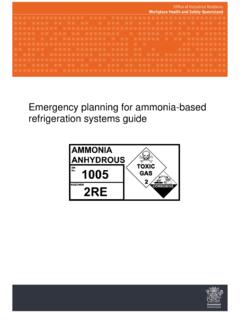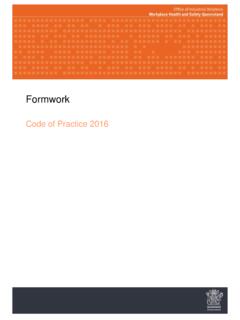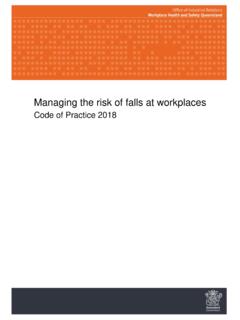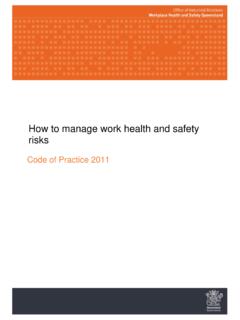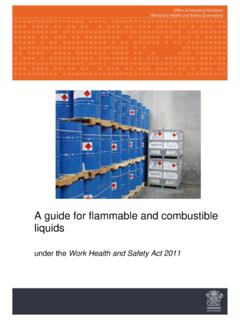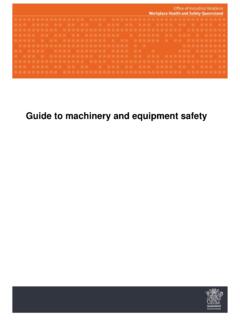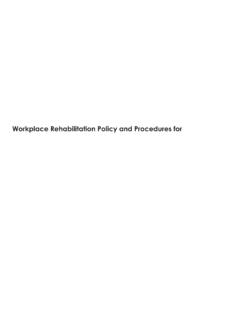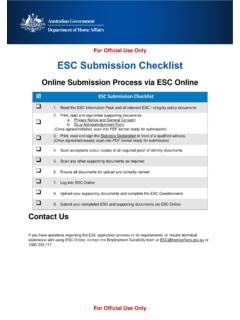Transcription of Information for employers - Home | WorkSafe.qld.gov.au
1 Wages definition manual Information for employers Table of contents Introduction .. 3. Reviews and queries .. 3. Definitions .. 3. Legislative references .. 3. Key wage items .. 4. Included in assessment .. 4. (a) Total of all PAYG gross salary and wage payments .. 4. (b) All superannuation payments including super salary sacrifice .. 6. (c) Fringe benefits and other entitlements having a monetary value .. 7. (d) Total of all individual contractor payments for deemed workers .. 8. Excluded from assessment .. 9. (e) Any allowances or expenses reimbursed for work-related expense included in (a) .. 9. (f) Lump sum termination payments included in gross wages (a) .. 9. (g) Excess period payments .. 9. (h) Compensation payments reimbursed by WorkCover .. 10. (i) All payments made to, or in respect of, Directors / Trustees / Partners .. 10. Apprentice 10. (j) Wages paid to apprentices .. 10. COVID-19 payments .. 11.
2 (k) COVID-19 Government JobKeeper Subsidy payments .. 11. (l) COVID-19 Workforce Retention Bonus Grant top-up payments .. 11. (m) COVID-19 JobMaker Hiring Credit .. 11. Index .. 13. This document is intended for Information purposes only, it is not a comprehensive statement of the law. Controlled uncontrolled if printed/copied 30 August 2021 | BK100 V27. Introduction Your accident insurance policy which covers your business for the cost of any work-related injuries to your workers is renewed yearly. To maintain your cover, you need to declare your wages Information between 1. July 31 August each year. WorkCover Queensland ( WorkCover') calculates your premium based on the actual wages paid during the last financial year, and the estimated wages you expect to pay in the current financial year. This manual will help you correctly declare your actual and estimate wages to ensure you have the right level of cover and pay the correct premium, and provide guidance for applying the relevant provisions of the Workers' Compensation and Rehabilitation Act 2003 ( the Act') and the Workers' Compensation and Rehabilitation Regulation 2014 ( the Regulation').
3 This document should not be construed as limiting the generality of the expression wages' or to modify any legal obligations under the Act or the Regulation. Reviews and queries Parts of the manual may be varied or expanded by the application of Common Law or Statute Law, and it is the intention of WorkCover to issue appropriate amendments to the manual as and when required. Definitions Wages are only assessable if paid to workers' by their employers ', as defined by the Act. The relevant legislative references, including the provisions containing key definitions, are outlined below. Legislative references WORKERS' COMPENSATION AND REHABILITATION ACT 2003. Section 11 Who is a worker' Schedule 2, Part 1 Persons who are workers Section 30 Who is an employer' Schedule 2, Part 2 Persons who are not workers Section 66 Employer's liability for Schedule 3 Who is an employer in particular circumstances excess period Schedule 6 Dictionary definition of wages'.
4 WORKERS' COMPENSATION AND REGULATION 2014. Regulation 9 Board and lodging To help employers declare the correct level of assessable wages when they renew their policy (between 1. July 30 September), WorkCover provides guidance when you renew your policy online, or a declaration of wages working sheet if not renewing through the online system. This document is intended for Information purposes only, it is not a comprehensive statement of the law. Controlled uncontrolled if printed/copied 30 August 2021 | BK100 V27. Key wage items This manual steps through the following key wage items in greater detail. Included in assessment (a) Total of all PAYG gross salary and wage payments (b) All superannuation payments including super salary sacrifice (c) Fringe benefits and other entitlements having a monetary value (d) Total of all individual contractor payments for deemed workers Excluded from assessment (e) Any allowances or expenses reimbursed for work-related expense included in (a).
5 (f) Lump sum termination payments included in gross wages (a). (g) Excess period payments (h) Compensation payments reimbursed by WorkCover (i) All payments made to, or in respect of, Directors / Trustees / Partners Apprentice discount (j) Wages paid to apprentices COVID-19 payments (k) COVID-19 Government JobKeeper Subsidy payments (l) COVID-19 Workforce Retention Bonus Grant top-up payments (m) COVID-19 JobMaker Hiring Credit Included in assessment (a) Total of all PAYG gross salary and wage payments PAYG gross salary and wages To be declared as wages. The amount declared should be the actual amount paid accruals or provisions are not assessable. Overtime payments To be declared as wages. Commission payments To be declared as wages. Allowances Allowances paid under an award or industrial instrument and which are compensatory or remuneration in This document is intended for Information purposes only, it is not a comprehensive statement of the law.
6 Controlled uncontrolled if printed/copied 30 August 2021 | BK100 V27. nature, in return for the employee rendering employment services (and do not represent a reimbursement of work-related/incidental expenses) are to be declared as wages. The following list of assessable allowances is not exhaustive and other allowances will need to be considered based on the individual circumstances . ASSESSABLE ALLOWANCES. First aid allowance Site or height allowance Higher duties allowance Skill allowance Instructors allowance Stand by or on call allowance Overtime allowance Travelling time payment Penalty rates Construction allowance Qualification allowance Dirt money Representation allowance Shift allowance Stipend The value of stipends paid to a worker is to be declared as wages. Generally, a stipend is a fixed regular payment, paid as a salary or allowance. Bonuses and incentive schemes The value of any bonus or monetary incentive provided to a worker (or their family) by an employer in return for work performed (or as an incentive to work) is to be declared as wages.
7 Leave payments Most leave payments made to workers are to be declared as wages. The table below details the most common leave types and their status for assessment: LEAVE PAYMENTS. Annual leave and leave loading All annual leave payments and leave loading is to be declared as wages. Unused annual leave and leave loading that is paid out as a lump sum upon an employee's termination of employment is not to be declared as wages. Sick leave and carer's leave To be declared as wages. Long service leave Long service leave that is paid to an employee who is still under an ongoing employment arrangement is to be declared as wages. Unused long service leave that is paid as a lump sum payment upon termination of an employee's services is not to be declared as wages. This document is intended for Information purposes only, it is not a comprehensive statement of the law. Controlled uncontrolled if printed/copied 30 August 2021 | BK100 V27.
8 Portable long service leave Portable long service leave providers such as Q-Leave and Coal Mining Industry (Long Service Leave) Corporation administer and pay long service leave for industry workers. Where an employer pays (instead of the provider) long service leave, this amount is to be declared as wages. However, if the employer claims reimbursement from the provider, the amount reimbursed by the provider can be deducted. Maternity leave Employer-paid maternity leave is to be declared as wages. Payments made under the Federal Government funded Paid Parental Leave (PPL) scheme are not to be declared. Paternity leave Employer-paid paternity leave is to be declared as wages. Payments made under the Federal Government funded Dad and Partner Pay' scheme are not to be declared. Jury duty/service leave An employer is required by law to continue to pay their workers their usual wage while they are on leave attending jury duty these payments are to be declared as wages.
9 Australian Defence Reserve Forces leave Payments made by an employer to a worker who is a member of the Australian Defence Reserve Forces while they are on leave to attend training and deployment purposes are to be declared as wages. Government training subsidies Wages payments by an employer to a worker, that are refundable under a government training scheme, are to be declared as wages. These payments represent wages having a monetary value. The fact that an employer can claim a reimbursement does not change their nature. Profit-sharing schemes A profit-sharing scheme describes an arrangement whereby the people who work for a business receive payments as a direct share of profits. If the payments made under this scheme are connected to the performance of work, ( are compensatory or remuneration in nature in return for employment services rendered), those payments are to be declared as wages. This could include dividends, trust distributions and bonus payments, depending on the circumstances .
10 Share of catch Payments made to a crew member of a fishing vessel on a per item basis or set dollar ($) amount per kilo are to be declared as wages. If a crew member of a fishing vessel receives a share of the gross earning/share of the catch, this amount is not to be declared as wages as they are not considered to be a worker'. For more Information on determining if your crew members are 'workers', please visit the Who should I cover Specific exclusions'. page on our website. (b) All superannuation payments including super salary sacrifice All superannuation contributions made by an employer on behalf of a worker are to be declared as wages. This includes payments made under the Compulsory Superannuation Guarantee Levy, payments an employer makes in addition to this amount, and payments made via a salary sacrifice arrangement. This document is intended for Information purposes only, it is not a comprehensive statement of the law.
